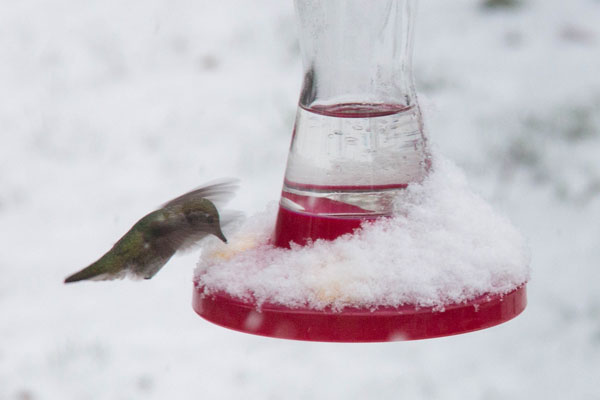
Dennis Forsyth writes: The three resident Anna’s at our place seem to be coping well with the current conditions. (around -1 Degrees C – Ed.) I suppose the real test comes next week when night temperatures are forecast to plummet. Even though these little guys do spend the long nights in a kind of torpor with heart and respiration rates slowed to minimal speed ( at least, minimal for a hummingbird) I still worry a bit about them. I’m guessing they must also produce some kind of anti-freeze compounds.
What we notice is that while the three birds will chase each other from the feeder during the day, late evening, just before dark, and early morning, right at first light, brings on a truce as they all move in and spend an extended period of time refuelling. Of course we do bring the feeder in overnight and get it back out before dawn next morning. Dennis
Deborah describes the action at her place: Typically I have one resident male, a regularly visiting male (which induces territorial displays of circling & vocalizing) and two females who visit the feeder occasionally. I can distinguish between the two males easily enough as the younger of the two has very white fluffy ‘pantaloons’, I cannot tell the two females apart but know there are two in the area as they will sometimes be at the feeder together. The females appear to tolerate sharing the feeder better.
Yesterday with the cold I realized I was seeing five Anna’s circling or attempting drink at the one feeder which I had been rotating out with a second staying warm in the house. I decided to put both out at the same time in order to give more distance for the two males but as the afternoon wore on the two feeders were cooling very quickly so I put the call out on the facebook bulletin board & borrowed two more. Just before dark last night there were six Anna’s feeding heavily.
I removed the ‘rests’ off the feeders in the afternoon so that all would hover to feed and not get to chilled while sitting & drinking. Deb

